#book of runes
Text
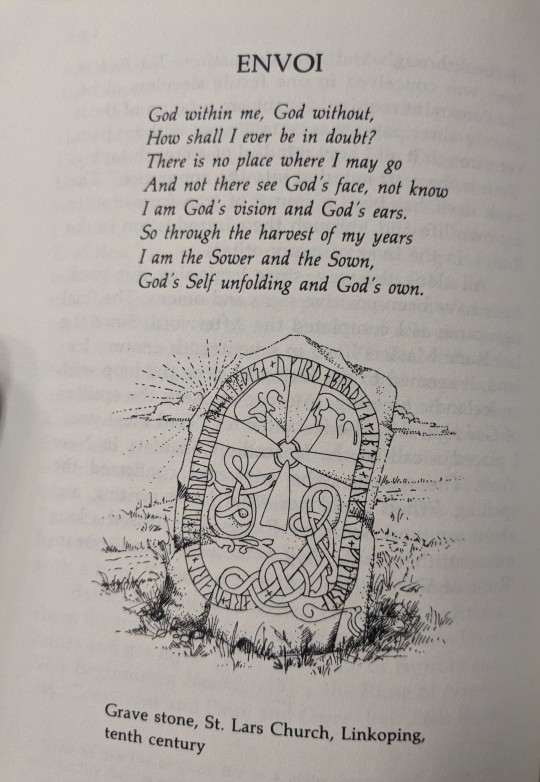
The Book of Runes by Ralph Blum
#ralph blum#ralph h blum#the book of runes#book of runes#poetry#christ#jesus christ#Christianity#futhark#elder futhark#runes#rune#book tag#medieval
22 notes
·
View notes
Text
Rune Lazuli // Jerzy Kosiński


#Rune Lazuli#Jerzy Kosiński#quotes#dark academia#light academia#classic literature#book quotes#poetry#chaotic academia#love
18K notes
·
View notes
Text

📷 handfulsofdust
#grimoire#book of shadows#crystal witch#witchblr#witches of tumblr#witchcraft#wicca#pagan#witchy things#witchy#magick#nordic runes#candle magick#candle magic#witch's altar#altar#norse runes#crystal ball#spellwork#wicca aesthetic#witch aesthetic#ritual candle#ritual#witch community#wand
940 notes
·
View notes
Text

Tiny Token 10
#tiny token#yes btw the runes on the book read 'books are cool'#sleep token#sleep token fanart#vessel fanart#vessel i#vessel ii#vessel iii#vessel iv#vessel sleep token#sleep token vessel#ii sleep token#sleep token ii#iii sleep token#sleep token iii#iv sleep token#sleep token iv#i#ii#iii#iv#sleep token band#sleeptoken#levynn tries to draw
176 notes
·
View notes
Text

#magic runes#witches of tumblr#rune casting#spellcraft#spells#witchythings#witches#pagan wicca#pagan witch#book of shadows#grimoire#spellbook#witch tips#solitarywitch#sea witch#divination#wiccan#magick#casualwitchcraft symbols#casualwitchcraft bookofshadows
569 notes
·
View notes
Text
Types of divination
Divination refers to the practice of seeking knowledge or insight about the future or hidden information through supernatural or mystical means. There are numerous types of divination found across cultures and traditions.
Here are some of the commonly known ones:
Astrology: Astrology involves interpreting the positions and movements of celestial bodies to gain insight into human affairs and predict future events.
Tarot Reading: Tarot cards are used to gain insight into the past, present, and future events or to explore various aspects of a person's life.
Palmistry: Palmistry, also known as chiromancy, involves analyzing the lines, shapes, and markings on a person's hand to make predictions about their life, personality, and future.
Numerology: Numerology is based on the belief that numbers hold symbolic meanings and can be used to gain insight into a person's character, talents, and future events.
Runes: Runes are ancient Germanic alphabet symbols that are used for divination. They are typically engraved on small stones or wooden tiles, and the reader interprets their meanings based on their arrangement.
Scrying: Scrying involves gazing into a reflective surface, such as a crystal ball, a mirror, or water, to receive visions or insights about the past, present, or future.
Tea Leaf Reading: Also known as tasseography, this method involves interpreting patterns and symbols formed by tea leaves in a cup to gain insights or make predictions.
Pendulum Dowsing: Pendulum dowsing uses a weighted object, often a crystal or metal pendant, suspended from a string or chain. The movement of the pendulum is interpreted to answer yes or no questions or to provide guidance.
Ouija Board: Ouija boards are flat boards marked with letters, numbers, and symbols. Participants place their hands on a small planchette and ask questions, believing that spirits will guide the movement of the planchette to spell out answers.
These are just a few examples of divination practices. It's important to note that the effectiveness and interpretation of divination methods vary widely, and their validity is often a matter of personal belief or cultural tradition.
#astrology#tarot reading#palmistry#numerology#runes#ouija board#pendulum#tea leaf reading#scrying#witchblr#witchcore#witchcraft#witchlife#white witch#beginner witch#witch tips#grimoire#Divination#spirituality#book of shadows
615 notes
·
View notes
Text

Sources:
Chamberlain, Lisa. Runes for Beginners: A Guide to Reading Runes in Divination, Rune Magic, and the Meaning of the Elder Futhark Runes. Chamberlain Publications, 2018.
Kristen. “15 Best Herbs for Protection.” Schisandra & Bergamot, 19 Feb. 2023, schisandraandbergamot.com/herbs-for-protection/.
“Animal Symbology: Animal Spirit Guides: Shamanism.” Animal Symbology | Animal Spirit Guides | Shamanism, www.wicca.com/animal-guides/symbology.html. Accessed 21 Oct. 2023.
#grimoire#baby witch#hedge witch#witch tips#beginner witch#baby witch tips#book of shadows#protection magic#protection magick#magical properties#protective spell#nazar#crystals 101#rune magic#animal symbolism#witch's bell#candle magic#sigil magic#protective sigils#green witch#freyja#pagan witch#altar
205 notes
·
View notes
Text

In the library of Castanamir the Mad (Jeff Easley, AD&D module C3: The Lost Island of Castanamir by Ken Rolston, TSR, 1984)
#D&D#Dungeons & Dragons#Jeff Easley#wizard#mage#magic user#The Lost Island of Castanamir#AD&D#wizard's library#runes#library#magic book#magic tome#dnd#Ken Rolston#Dungeons and Dragons#TSR
455 notes
·
View notes
Text

Rune Garden
Hávamál, Rúnatal
138. Veit ek at ek hekk vindga meiði á
nætr allar níu,
geiri undaðr ok gefinn Óðni,
sjálfr sjálfum mér,
á þeim meiði er mangi veit
hvers hann af rótum renn.
I know that I hung on a windy tree
for all of nine nights,
wounded by a spear and given to Odin,
myself to myself,
on that tree of which no one knows
the kind of roots it runs from.
139. Við hleifi mik sældu né við hornigi,
nýsta ek niðr, nam ek upp rúnar,
œpandi nam; fell ek aptr þaðan.
They blessed me with neither bread nor horn,
I peered down, I took up runes,
screaming I took them; I fell back from there.
#runes#runic#old norse#norse#calligraphy#book art#odin#heathen#pagan#norse paganism#norse polytheism
140 notes
·
View notes
Text

the cutest little bro
#oodles of doodles#rune factory 4#rf4#rf4 kiel#kiel#how the hell does that book stay on his side belt#magic ig
89 notes
·
View notes
Photo




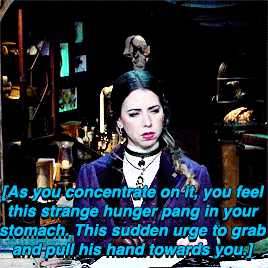



“After Eddie went missing, I didn’t want anyone to have to suffer through that anymore. I wanted to find answers.”
#critical role#candela obscura#arlo black#ygifs#help my weird girly got doomed by the narrative and i don't want to watch her die#no but watching her is like reading a book so naturally I need to be utterly obnoxious about her#in ep1 when she Thought of eddie and Knew to offer blood to a rune. like she just Left that detail out when she spoke of him INSIGHT CHEC#saying oldfaire relics interested Eddie and yet She also knows of the lure of it??? INSIGHT CHEC#asking for something to combat shadow beasts and then DOESN'T want it on her person?? INSIGHT CH#no but like is it GRIEF that's motivating her or GUILT girl spinning in my head im chewing#them being like we'll find eddie! and she's like maybe :). GIRL#i'm saying only one more episode with arlo isn't acceptable I need at least 10 what
258 notes
·
View notes
Text
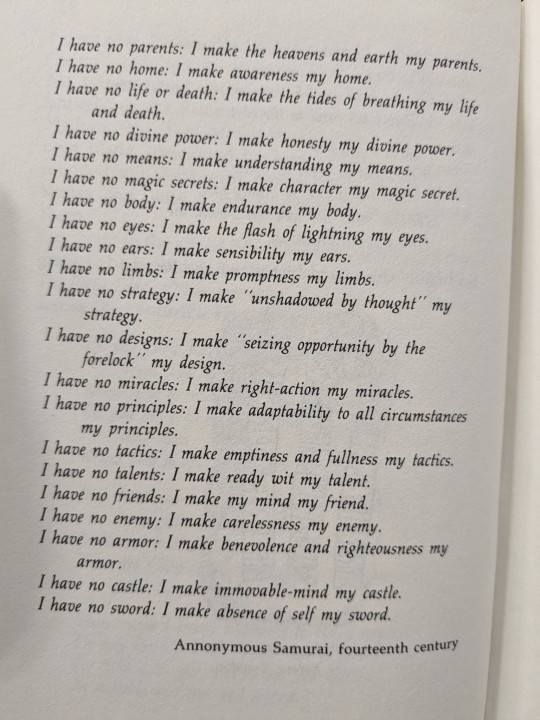
The Book of Runes by Ralph Blum
#ralph blum#ralph h blum#book of runes#the book of runes#samurai#poetry#japan#medieval#book tag#futhark#elder futhark
9 notes
·
View notes
Photo



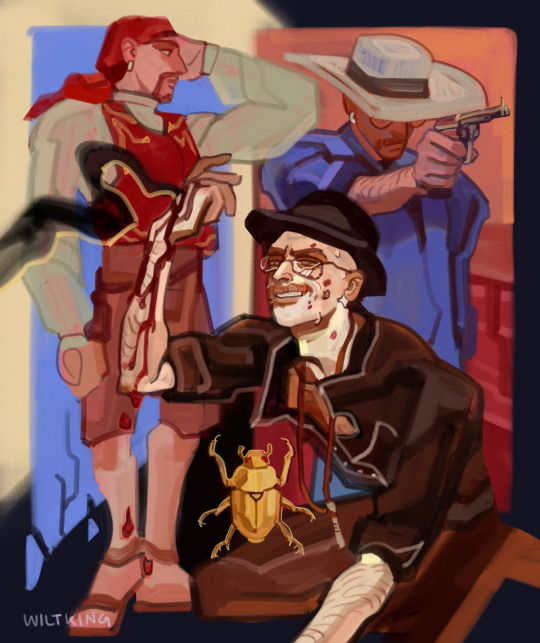

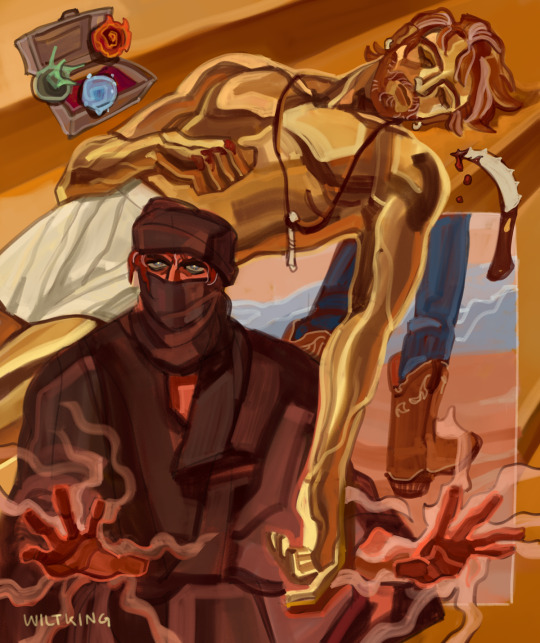
“I don’t know who I am anymore, Grace. I don’t even know what I am.”
“You are and always will be the man we love.”
Travis Wilder from The Last Rune by Mark Anthony
#'ill draw all of his iconic outfits' i said 🤡#'itll be quick and simple' i said 🤡#i started these in november.#alas i dont regret it#travis wilder#the last rune#lgbt books#digital#fanart#original art#really started these with no plan whatsoever but by the end i think i had a nice groove going :')#so happy i got to read this series. will likely draw a few more things from it#so watch out!#book fanart
865 notes
·
View notes
Photo
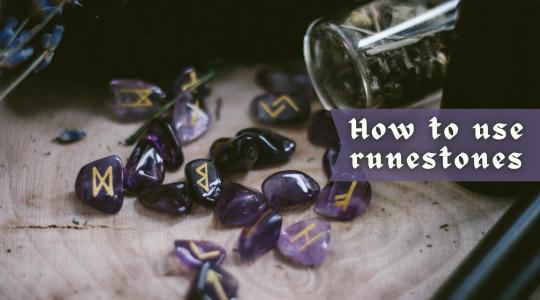
A Complete Guide to Runestones
Casting and reading the runes is a popular form of divination in modern new-age practice. It is based on an old Germanic and Norse practice linked with the practice of Heathenry and the worship of Odin and other northern European pagan gods.
Like many other forms of divination, the practice is designed to help you access your intuition or your spiritual senses to bring to the surface truths that you already know in your heart. Your subconscious mind is much more powerful than your conscious mind and has information you simply cannot take in consciously. Practices such as rune casting let you quiet the conscious mind so that your subconscious mind has space to speak and reveal.
You can read more about the underlying philosophy of divination in our post about using the Tarot.
In this article, we will take you through several methods for casting rune stones for divination and how to interpret the runes. At the end of the article, we will also take a closer look at the history of the runes from ancient times to modern practice.
How to Read the Runes
Since rune casting is all about tapping your intuition and divine spark, there is no single right way to use them. Many experienced rune readers have developed their own approaches and shared them, so look around for ideas and inspiration.
But any approach will involve holding a question in your mind and then casting, placing, or selecting stones that will guide you toward a response.
Before you start, there are a few steps that you should take.
Find a set of runestones that speaks to you spiritually – you can shop our runestone collection here.
Connect with your rune stones by spending time with them. This should be physical, holding them in your hands and examining them, and intellectual, reading your guidebook and taking in the meanings associated with the different runes.
Prepare yourself through meditation that helps you to quiet your active mind and let your subconscious mind flow to the surface.
Learn how to ask questions, which should be open-ended, since all things are possible, rather than yes or no questions.
Read our more detailed guide to preparing for a divination session here.
Before every individual casting, you should also cleanse your rune stones of energy other than your own. You can protect your rune stones by storing them with energy-cleansing crystals such as black obsidian, citrine, or amethyst. You can also cleanse your cards by leaving them under the light of the moon for a night or smudging them with incense. You should then hold the runestones in your hands for several minutes before a reading to make a connection between yourself and the runes.
Casting Patterns and Methods
There are many different ways to then use the runes to find answers, but we will go through some of the simplest and our favorites below.
The Three Norns
Hold your runestones while considering your question, and then retrieve the rune stones that seem right either from your hands or from a sack. Place three runestones in a row in a horizontal line. The first runestone will reveal the major causes of your current challenges. The middle stone will represent the reality of your current situation, which we are often blind to. The final runestone will indicate the best course of action going forward.
The Four Dwarves
This casting works in the same way, except that you will place four runestones in a circle, working clockwise from the top. The top rune indicates the main causal factors of your situation. The runestone on the right suggests that you are doing that is influencing the current situation, while the left indicates what others might be doing or feeling. The bottom runestone indicates the reality of what is happening that is currently hidden from you.
Vé Branches
This is a more complex casting that uses seven runestones laid out in a V shape. Start with the bottom rune and work upwards, placing runes on the right and then the left. The rune at the bottom represents the truth of your current situation, and each line represents one of the most likely outcomes. The first rune represents your most likely action, the second your motivation for that action, and the third what the result is likely to be.
Rune Board
Other casters use a rune board. This can be designed in various ways but will have different areas that relate to different elements. It could be past-present-future, cause-affect-outcome, or different aspects of your personality. In this case, when you are ready to ask your question, you throw the runes over the board and make your reading based on where they land.
Individual Rune Meanings
There are many different rune designs, and each will come with its own guide with different meanings and interpretations. Also, as you become accustomed to the runes and grow close to them, you will start to develop your own meanings and associations.
Nevertheless, below are the most commonly accepted meaning for the Armanen runes, the runes most commonly used in rune casting.
Fa – Primal Fire – power of spirit, change, and creativity
Ur – Resurrection – physician’s rune for resurrection, eternity, and continuity
Dorn – Lightning and Thunder – targeting goals, activity, masculinity
Os – Mouth – spiritual power, voice, gaining power and respect
Rit – Ritual – orderliness, primal law, cynical events, rescue from an enemy
Ka – World Tree – power, generation, ability, and artfulness
Hagal – Hail – mother rune represents enclosure and contains potential for growth
Not – Necessity of Fate – karma, future existence
Is – Ego – self-control, personal power, obedience, compelling will
Ar – Leadership – beauty, fame, intelligence, virtue
Sig – Sun Power – success and victory
Tyr – Rebirth of the Sun God – turn a situation around, wisdom, spiritual understanding
Bar – Birth – creative power, becoming, song
Laf – A-rlog – defeat, laws or nature, water
Man – Manking – birth, health, increase, maleness
Yr – Bow – femaleness, nigh, death, instinct, anger, falsehood
Eh – Duality – love, trust, and marriage
Gibor – Gift of Life – cosmic consciousness and divine principle
Where do the Runes come from?
Various northern European peoples used runes as a system of writing. Probably the most widespread runic language was Futhark, used by the Norse people. They used a 24-character alphabet known as Elder Futhark between the 2nd and 8th centuries, which developed into a smaller 16-character alphabet known as Younger Futhark from the 8th century. At around the same time, the Anglo-Saxons and Frisians developed a related Runic alphabet known as Anglo-Saxon Futhorc.
Across all these groups, the runes became less popular with the rise of Christianity, and they were replaced by the Latin alphabet.
The Norse people believed that their runes were more than just a system of writing but rather a tool used to shape reality. The Norns, the fates in Norse mythology, write destiny into the bark of Yggdrasil using the runes. Odin, the most important Norse deity, saw the Norns at their work and was jealous of their knowledge. He hung himself from the World Tree, Yggdrasil, for nine days and nine nights while pierced by his own sword to learn the secrets of the runes, which he then shared with mankind.
In the Norse sagas, many heroes are described as runemasters who can use the runes to heal the sick and destroy their enemies. There are also many surviving archaeological examples of objects inscribed with runes seemingly meant to provide protection or ensure the quality of something stored. But, since the pagan Norsemen left no written records and our knowledge principally comes form later Christain texts, we do not know very much about how the Vikings used the runes.
We do know that centuries later, the Norse people of Iceland combined the runes to create runic staves believed to have magical properties. These are recorded in several magical grimoires surviving from the 17th, 18th, and 19th centuries. Some of the most famous runic staves in these magical texts include Aegishjalmur, also known as the Helm of Awe, a symbol of protection, and Vegvisir, also known as the Norse Compass, a powerful wayfinding symbol.
Ancient to Modern Runic Divination
We know that the Norsemen also engaged in divination. Volva were witch women highly respected in society that were often called upon to act as seeresses. That their practices may have included rune casting is indicated by a much older text.
The first-century Roman author Tacitus observed similar witches among the Germanic tribes of his day. He said that the runes were carved into small objects, such as sticks and bones, which would then be cast onto the ground. The seeress would make a reading based on how the runes fell.
But while runic divination seems to have existed in some form for at least 2,000 years, the modern practice dates to the 17th century. Johannes Bureus, a Swedish mystic, was inspired by the practices of his ancestors and made the modern system based on combining the Younger Futhark runes with the Kaballah, a Jewish mystical tradition.
His work was further developed in the 1900s by the Austral occultist Guido von List. This is the most common system used today and is known as the Armanen runes.
[Read The Full Blog Post Here]
#grimoire#runestones#runes#rune stones#witch#witches#witchy#witch tips#witchcraft#wicca#wiccan#pagan#paganism#occult#baby witch#beginner witch#witches of tumblr#divination#book of shadows#paganblr#witchblr
971 notes
·
View notes
Text

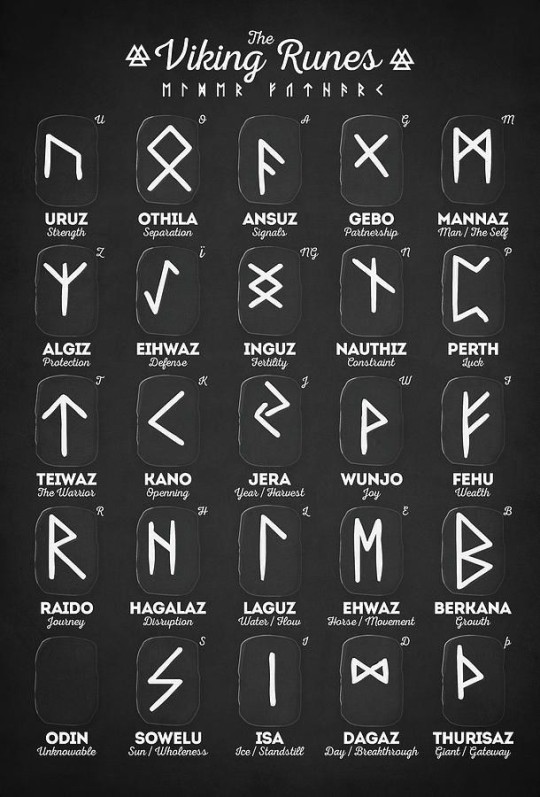

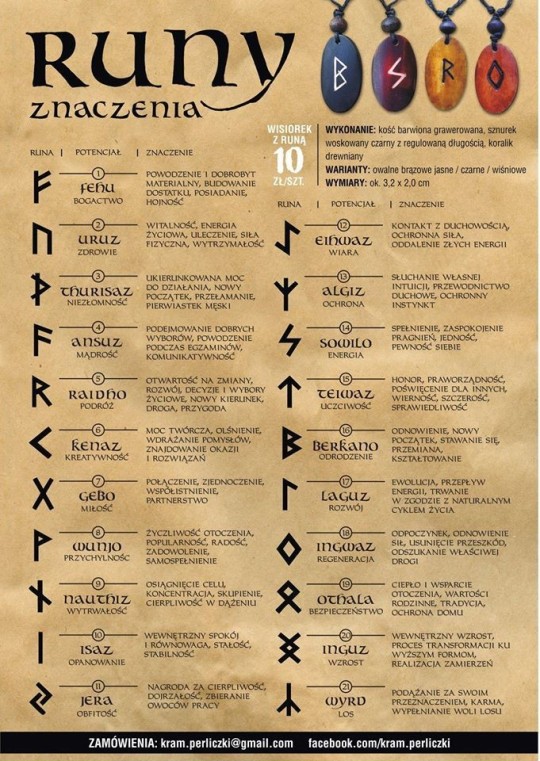
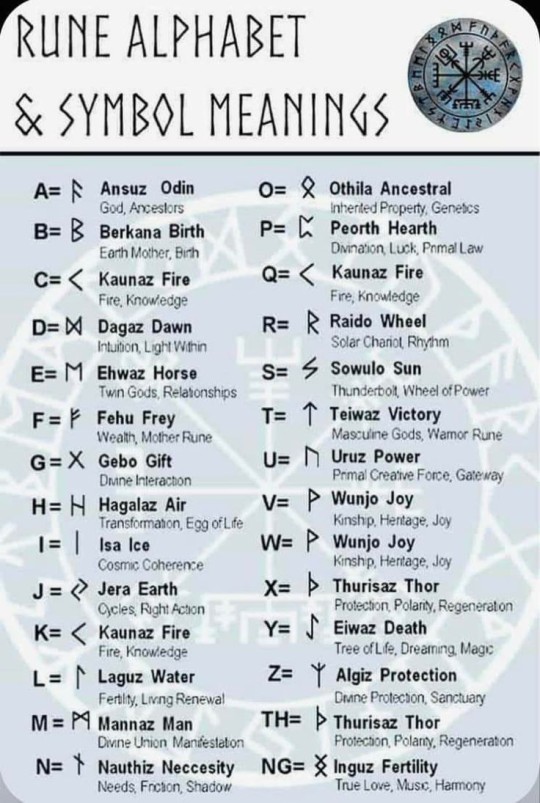
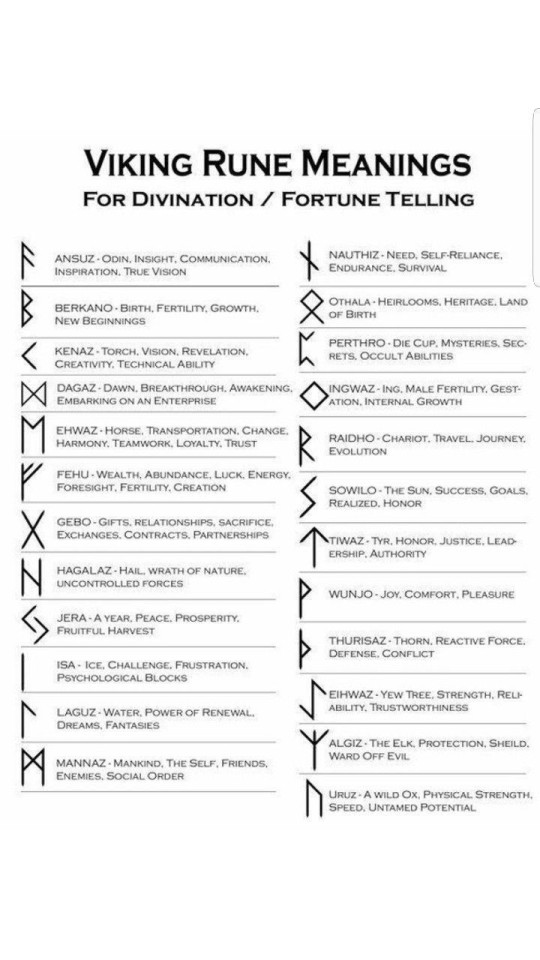
#simbols#sigils#futhark runes#runes art#norse runes#divination#grimoire#norse paganism#ancient culture#vikings#paganism#pagan#simbolos#spells#witch#witchcraft#witchblr#book of shadows#dark aesthetic#norse mythology#ancient history#history#celtic#beginner witch#beginner witches#kitchen witch
108 notes
·
View notes
Text
Divination magick
Divination is the practice of seeking insight, guidance, or knowledge about the future or unknown through supernatural or intuitive means. It is an ancient and widespread practice found in various cultures and spiritual traditions throughout history. Divination can be approached in different ways, using various tools, techniques, or intuitive abilities.
Here are some common forms of divination:
Tarot Reading: Tarot cards are a popular tool for divination. A tarot deck consists of 78 cards with symbolic images that are interpreted to provide guidance and insight into different aspects of life, including relationships, career, and spiritual growth.
Astrology: Astrology involves studying the positions and movements of celestial bodies to interpret their influence on individuals and events. It is based on the belief that celestial bodies can provide insights into personality traits, life events, and future possibilities.
Runes: Runes are ancient symbols or letters carved on stones or pieces of wood. They are used in divination to receive guidance and answers to specific questions. The runes are typically drawn or cast, and their meanings are interpreted based on their position and the intuitive insights they evoke.
Scrying: Scrying is a practice of gazing into a reflective surface, such as a crystal ball, mirror, or water, to induce a state of altered consciousness and receive visions or symbolic messages. The interpretation of what is seen relies on the practitioner's intuitive abilities.
Pendulum Divination: Pendulum divination involves suspending a weighted object, such as a crystal or metal pendant, and asking yes or no questions. The movement or direction of the pendulum is interpreted as a response from the spiritual realm.
Numerology: Numerology is the study of the symbolic meanings of numbers and their influence on human life. It involves calculating and interpreting numbers associated with names, birthdates, or events to gain insight into personality traits, life cycles, and potential outcomes.
Palmistry: Palmistry, also known as chiromancy, involves analyzing the lines, shapes, and features of the palm to interpret personality traits, character, and potential life events. Different areas of the hand are associated with different aspects of life, such as love, career, and health.
Tea Leaf Reading: Tea leaf reading, or tasseography, is a form of divination in which patterns and symbols formed by tea leaves in a cup are interpreted to gain insight into the future or receive guidance. The reader interprets the symbols and images left by the tea leaves.
It is important to approach divination with an open mind and understanding that it does not provide absolute predictions but offers guidance, possibilities, and insights into the energies and influences surrounding a situation or person. The effectiveness of divination depends on the skill, intuition, and connection of the practitioner with the chosen tool or technique.
#divination#Divination magick#witchblr#witchcore#witchcraft#witchlife#white witch#beginner witch#witch tips#grimoire#spirituality#book of shadows#tarot#tarot reading#astrology#runes#scrying#pendulum divination#numberology#palmistry#tea leaf reading
207 notes
·
View notes